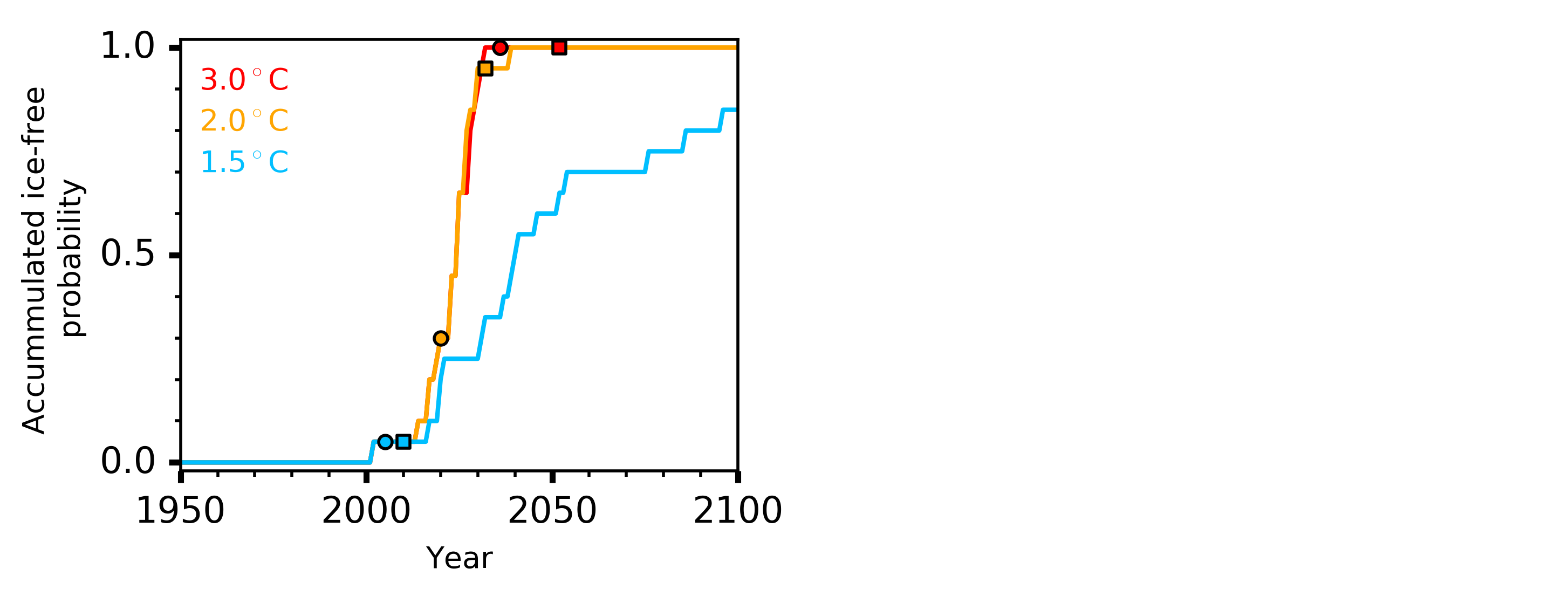Ice-free Arctic projections under the Paris Agreement

Fig. 1: The probability of reaching an ice-free Arctic at least once under 1.5°C (blue), 2.0°C (orange) and 3.0°C (red) global mean warming. Circles correspond to years when the warming threshold is first exceeded and squares correspond to years when the global mean temperature has stabilized. (Source: Sigmond et al., 2018)
Under business-as-usual scenarios the Arctic Ocean is expected to become ice-free in summer by mid-century. An ice-free Arctic would fundamentally change Arctic ecosystems and communities, and is expected to impact weather at lower latitudes where most people live. Under the 2015 Paris Agreement, nations agreed to limit global mean warming to 2°C, while also working toward the more ambitious goal of limiting warming to 1.5°C. However, current pledges to support the Paris Agreement would only limit global warming to 3°C. Would meeting the Paris temperature goals be sufficient to avoid an ice-free Arctic?
This question was addressed in a recent paper that appeared in Nature Climate Change. Michael Sigmond and colleagues used an Earth System Model to perform large ensembles of simulations that stabilize at 1.5°C, 2.0°C and 3.0°C global mean warming. Biases in the simulation of mean (climatological) sea ice coverage were corrected for by using observations to constrain the sea ice projections. The observationally constrained simulations show that under 1.5°C global mean warming, the probability of an ice-free Arctic stabilizes around 2.4%. This implies that under this most ambitious scenario, one in every 40 summers will be ice-free. Allowing an additional 0.5°C warming would substantially increase the probability of ice-free summers to 19%, or one in every 5 summers. Under 3.0°C global mean warming, every summer is expected to be ice-free. This implies that current emissions reductions commitments made under the Paris Agreement are unlikely to be sufficient to avoid a consistently ice-free Arctic in summer. On the other hand, meeting the 1.5°C temperature target would significantly limit the risk of ice-free summers.
The study also calculated the probability of ever reaching ice-free conditions under the Paris temperature goals (i.e. the probability of experiencing ice-free conditions at least once). A previous study had attempted to quantify this from transient warming simulations by considering the ice conditions in the period prior to reaching the Paris temperature targets. An important finding of the Sigmond et al. paper is that the probability of ever reaching ice-free conditions continues to increase after the global mean temperature has stabilized. For example, while the likelihood of reaching ice-free conditions at least once is only 5% by the time that 1.5°C is first reached, it increases to 85% around a century after temperature stabilization (Fig. 1).
In conclusion, this paper showed that while meeting the Paris Agreement temperature goals would significantly limit the risk of an ice-free Arctic, occasional ice-free summers are likely even under the 1.5°C scenario. Ice-free summers are expected to be rare at 1.5°C warming (1 in 40), more frequent under 2.0°C warming (1 in 5) and are likely to occur every year if nations do not increase their commitments to support the Paris Agreement. These results are consistent with another study with a different climate model that appeared in the same issue of Nature Climate Change, as also described in an accompanying News and View article.
Summary written by Michael Sigmond.














Add new comment